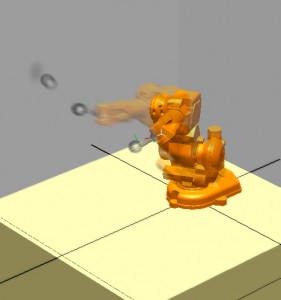Post-Industrial Robotic Culture | Madeline Gannon
For the Future of CNC Machines, I envision a point in time when the level of robots-to-tasks is opposite of the current status quo: while today there are, arguably, less tasks formatted for CNC operations than there are able machines ( see eBay.com ), my proposal speculates that systematic integration and machine/material efficiencies in robotics will push beyond the 1:1 equilibrium to an era when there are more able robots to viable tasks. With an over-abundance of robots to directives, perhaps it will no longer be necessary for every robot to run at peak efficiency … perhaps the robot will have leisure time in between tasks or jobs.
Because of their propagation and efficiency, what if this increased leisure time led industrial robots to develop CULTURE? A kind of music, art, language, or sport unique to the industrial robot as a species, without mimicking human culture ( see bottom section of post ). When the robot is not executing a task, what if it ran programs without a point or objective … doing things for the sake of doing things … exploring the limits of itself and its environment.
+ + + + +
I propose to develop a series sub programs that our robot has the ability to run while it’s not being explicitly used. The programs are categorized as CREATIVE, MODIFYING, or TIME-PASSING:

CREATIVE: By vibrating about its joints, the robot will develop an audible syntax, perhaps analogous to humming or grunting.

CREATIVE: The goal is not to find harmonics equivalent to music, but rather to explore sounds native to the robot.

CREATIVE: By using itself, or object in its immediate environment, the robot will be able to explore rhythm.

MODIFYING: By repeatedly throwing heavy objects at the same point, the robot has the opportunity to create holes and explore beyond its surrounding enclosure.
A simple sound study exploring the rhythms and patterns that are possible when a 6-axis industrial robot oscillates one joint.
While the notion of Robot Culture is highly speculative, the behaviors described above may have sincere pragmatic applications when industrial are used only intermittently. The behaviors may serve a dual purpose as a sort of robotic calisthenics… circulating fluids, preventing oxidation or gaskets rotting, reporting malfunctions before being given a task, or recalibrating tolerances…the behaviors could even be viewed as longevity or survival tactics.
_________________________________________________________________________________________
_________________________________________________________________________________________
Going Beyond Performance / Routines
The majority of novel applications in industrial robotics are created to either (1) entertain bored programmers or (2) entertain/perform for an audience … why not create a framework for a robot to entertain itself?
Below is a sampling of projects that, although perhaps technically challenging, do not envision the robot beyond its existing capacity in industrial settings:
Game Routines:
Soccer Ball
Ping-Pong
Dart Throwing KUKA
Dance Routines:
Musical Performances:



